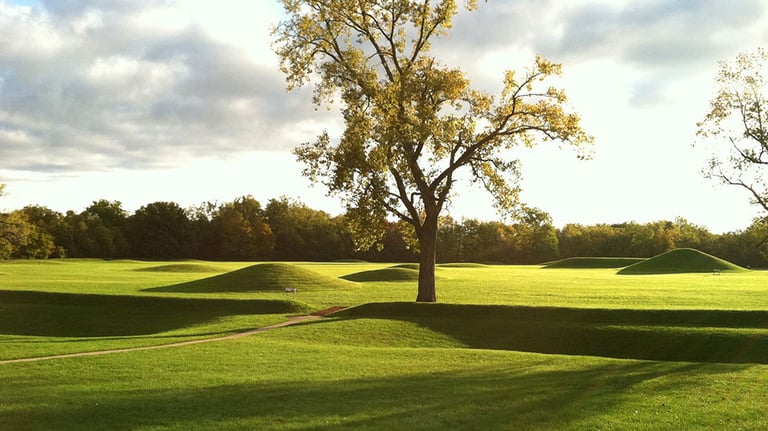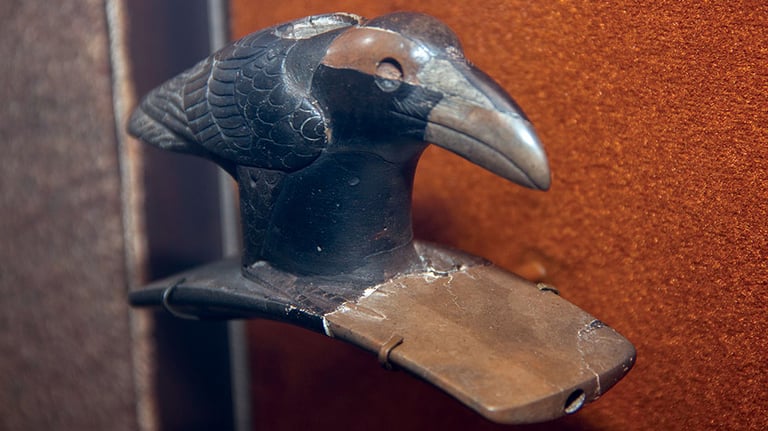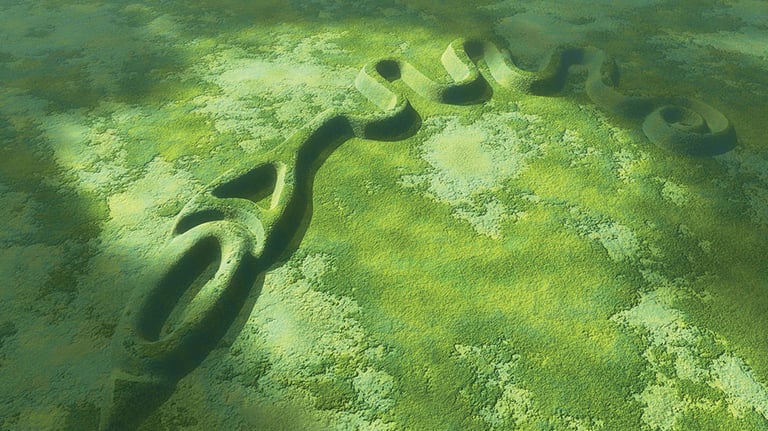Ohio’s Ancient Earthworks
An exploration of the mysterious mounds built by the hopewell people reveals the fascinating culture of a nearly lost american civilization

Throughout Ohio, hundreds of solitary mounds erupt seemingly randomly from the earth in fields and forests as well as in what are now cemeteries and city parks. Even more remarkable, huge complexes of geometrically shaped earthworks are scattered across the state.
For example, there’s a giant earthen circle 1,200 feet across near an even larger octagonal earthwork big enough to fit four Roman Colosseums inside. There’s even an enormous earthen serpent a quarter-mile long slithering along the saddle of a ridge.
Remnants of the civilizations that built these mounds—often referred to as the Mound Builders—can be found throughout much of the Eastern US, with Ohio being home to some of the world’s largest and most impressive such sites. Archaeologists believe the Mound Builders thrived for nearly 2,000 years until about the year 1200.
There’s evidence that at roughly the time of the Roman Empire, one of those Mound Builder cultures, the Hopewell people, had an especially wide sphere of influence. Artifacts found in Hopewell mounds in southern and central Ohio show that the people who created them had obtained copper from the upper Great Lakes, mica from North Carolina, seashells from the Gulf of Mexico and obsidian from the Rocky Mountains. At a time when all roads in Europe famously led to Rome, it could be argued that a similar trade route was taking shape in North America, with all roads leading to Ohio.
Archaeologists believe that the Hopewells lived in small villages in a loosely organized society without a centralized ruler. If that is indeed true, what brought these people together to construct these giant complexes of geometric earthworks, which required millions of cubic feet of dirt to construct? What motivated the people? And what were the earthworks for?

Brad Lepper, a senior archaeologist with the Ohio History Connection, has made studying the Hopewell culture his life’s work. He theorizes that one or a few charismatic individuals had a vision to construct these large complexes of mounds, a vision that caught fire among the Hopewell people. Hundreds or perhaps thousands of them would periodically travel from far and wide to deposit one basket full of dirt at a time, perhaps over the course of several years, until each mound structure was completed.
And the purpose of this community-building project? “Anything of such huge scale was surely a place of great importance to the Hopewells,” Lepper says. “After they constructed these sites, the Hopewells likely returned again and again for great ceremonial gatherings reflecting their deepest spiritual beliefs.”

Unraveling history and mystery
While the earthworks may raise questions more than provide answers, it’s partly this mystery that draws today’s travelers to explore the Hopewell sites. Fortunately, they have an easy job of it since state highways now connect these major sites, which lie roughly in a diagonal line across Ohio. An indispensable resource, the Ancient Ohio Trail (ancientohiotrail.org) provides details about each site and suggested itineraries, with a focus on four sets of earthworks under consideration by UNESCO for World Heritage designation: Newark Earthworks, Mound City, Serpent Mound and Fort Ancient.
A good place to start your exploration is the city of Newark, 40 miles east of Columbus. The Hopewell’s largest concentration of earthworks once stood here, covering an area of nearly four square miles. A Great Circle and an Octagon remain, the rest long ago covered over by the city of Newark.
Lepper believes this vast complex was the principal destination for Hopewell pilgrims, perhaps attracting thousands of visitors at a time. “This was their Jerusalem, their Mecca,” he says.
It’s possible to enter the Great Circle and visualize these huge gatherings, but the Octagon on most days can be viewed only by mounting platforms along its exterior. It’s still worth a visit, however, because it illustrates the Hopewell’s advanced knowledge of astronomy; openings in its walls mark the complex movements of the moon over a lengthy 18.6-year cycle. Signage at the site explains that “aligning their architecture with cosmic rhythms was one way in which ancient Native American builders marked these places as sacred.”
From Newark, proceed southwest to the city of Chillicothe, situated in the broad fertile valley of the Scioto River. Lepper calls this “the epicenter of the Hopewell universe” since the great number of mounds throughout this region indicate a large population of Hopewell people once lived here. An exact replica of Newark’s Octagon was also constructed in Chillicothe, although today only an outline of this second earthwork can still be seen.

That site, now called High Bank Works, is one of six separate locations that constitute Hopewell Culture National Historical Park. The most dramatic site is aptly called “Mound City” because of its cluster of 22 mounds covering 15 acres. A visitor’s center here gives an excellent introduction to Hopewell culture and includes artifacts created by skilled artisans, such as a copper deer effigy headdress and pipes in the shapes of ravens, otters and wildcats.
Farther to the southwest, the earthwork that’s arguably the most beloved among Ohioans is the Serpent Mound, which snakes across a hilltop plateau, its body gracefully undulating, its tail spiraling into a coil, and its head swallowing what looks like a giant egg.
For an overview of the Serpent Mound’s complexity, climb the high platform at its edge. Many archaeologists believe it was constructed around the year 1070, not by the Hopewells but by the Fort Ancient culture that succeeded them and concentrated on building effigy mounds in the shapes of various animals.
Steep cliffs descend from the plateau where the Serpent Mound lies to wooded areas below. Venture on paths from the cliffs to follow a trail that leads to a spot where a giant rock can be seen jutting out from the cliff overhead, mimicking the shape of the snake’s head directly above and behind it, a placement that appears more than coincidental.

For your last stop, travel to Fort Ancient Earthworks north of Cincinnati, named before archaeologists knew that it was actually built by the Hopewell people, not those of the Fort Ancient culture.
In addition to misidentifying the Mound Builder culture that built it, early archaeologists also mistakenly surmised that the huge hilltop had been used as a fort. That theory is unlikely since the 67 gaps in its three-and-a-half-mile-long walls would have made defense against enemies difficult. Situated on a plateau overlooking the Little Miami River 235 feet below, this vast 100-acre enclosure was likely another ceremonial site.
A number of nature trails run through the Fort Ancient Earthworks site, including some overlooking the canyon-like river valley. A museum near the entrance of what is now called Fort Ancient State Memorial presents an overview of Native American history throughout Ohio up to the arrival of the Europeans as well as exhibits and dioramas depicting the everyday lives of the Hopewell people.
This summer and fall make especially good times to visit these four sites, before UNESCO decides on their World Heritage status. If that designation is made—perhaps as early as 2023—all roads may once again lead to Ohio.
